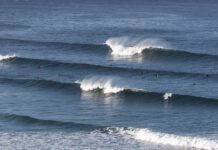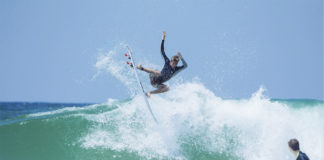Windguru is a handy website for surfers. It shows you the wind, waves, wave period, wave direction, air temperature, clouds, and tides.
But how do you use Windguru to determine when it’s good to surf? Here we explain it step by step.
What do you see on Windguru?
When you open Windguru , you see a table with various rows and columns. Let’s take a look at Biscarosse, a well-known surf spot on the west coast of France.
1. Wind Speed: At the top, you see the wind speed in knots (kts). This shows how hard the wind is blowing.
– Colors: Light blue or white means little wind, which is good. Green, yellow, red, or purple means stronger wind, which is usually less favorable for surfing.
2. Wind Direction: This is important for surfers. Wind from the east (offshore wind) is good because it smooths the waves. Wind from the west (onshore wind) makes the waves choppy.
3. Wave Height and Period: These indicate how high the waves are and how often they arrive.
– Wave Height: For beginners and intermediate surfers, 1 to 1.5 meters is perfect. This is indicated in meters.
– Wave Period: This is the time between two waves, indicated in seconds. 10 to 12 seconds is ideal because it means the waves are strong and regular.
4. Wave Direction: The direction the waves are coming from. A westerly component (e.g., northwest or southwest) is usually good on the Atlantic coast of France.
5. Weather Conditions: This indicates whether it’s sunny, cloudy, or rainy. Although this doesn’t directly affect the waves, it’s nice to know if you can surf in the sun.
6. Tide: This indicates whether it’s high or low tide. For smaller waves (often below 0.7 meters), surfing around low or mid-tide is usually better.
Example: Biscarosse
This is the forecast as we saw it at the time of writing this post, and it looked great. If you’re there for a week now…
This is what it looks like:

Why does this look good?
Let’s explain.
So, you’re looking at the forecast for Biscarosse:
- Wind Speed: You see that the wind is light blue or even white sometimes, which means there’s little or even no wind. This is good!
- Wind Direction: The wind is coming from the west, so onshore. This is generally less good news. But with such light wind, it doesn’t matter much. As long as it doesn’t exceed 11 to 12 knots, it’s fine. Ideally, you want wind from the east (offshore). This is the case on Saturday. This makes the waves nice and clean.
- Wave Height and Period: The waves are about 1.2 meters high with a period of sometimes 10 seconds. Sometimes a bit more, sometimes a bit less. Less than 9 seconds is little. More than 14 seconds is a lot. Then you quickly get close-outs. Waves that break all at once and don’t run out nicely.
- Wave Direction: The waves are coming from the northwest, which is ideal for this spot.
- Weather Conditions: Cloudy with some sun, perfect surf weather.
- Tide: Generally, all tides are good. But especially when the waves are lower, it’s better to avoid high tide completely. Mid-tide is usually your best choice.
Summary
When you read Windguru, pay attention to the following 7 things:
1. Light colors for wind (little wind is good).
2. Offshore wind direction (from the east).
3. Wave height between 1 and 1.5 meters.
4. Wave period between 10 and 12 seconds.
5. Westerly wave direction.
6. Mid-tide for smaller waves.
With this information, you can determine for yourself if it’s a good day to surf. It might take some practice, but soon you’ll have it mastered and know exactly when to catch the best waves!










